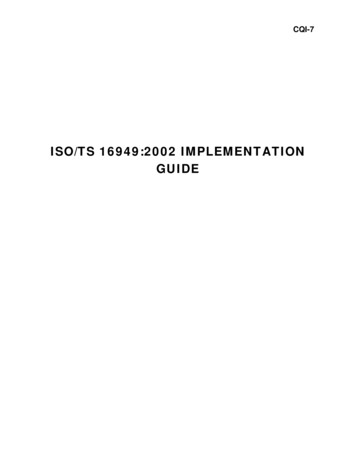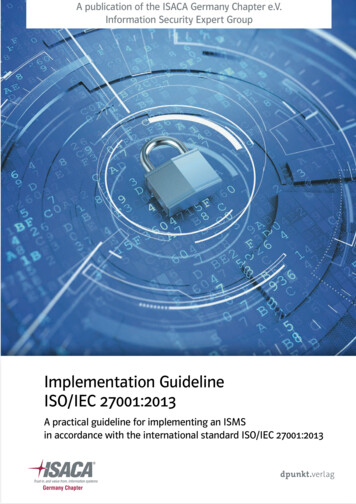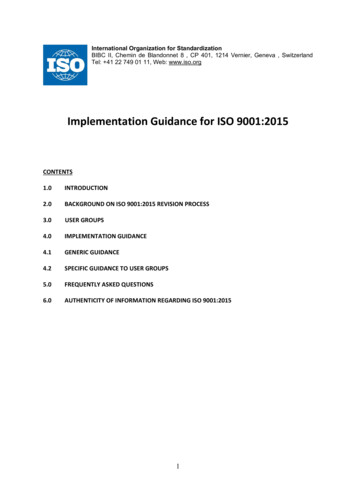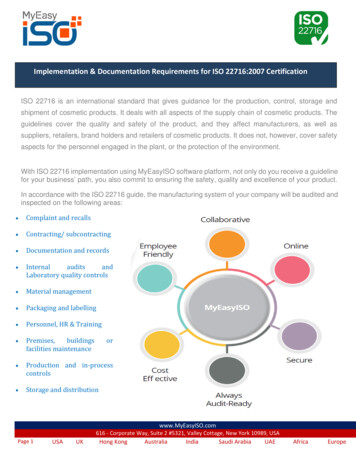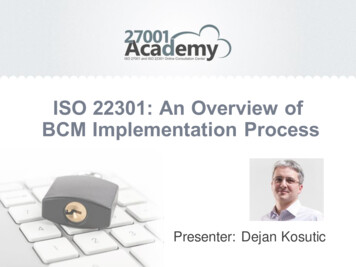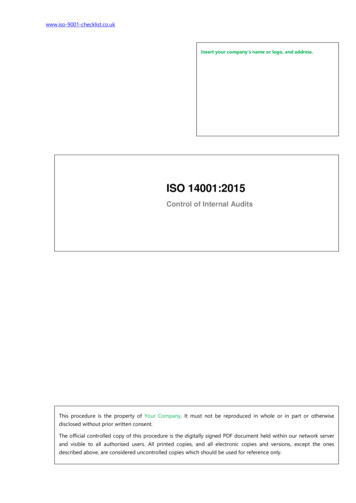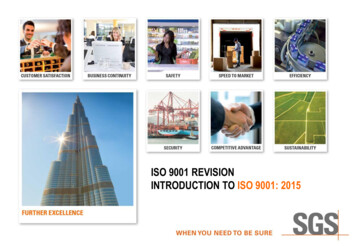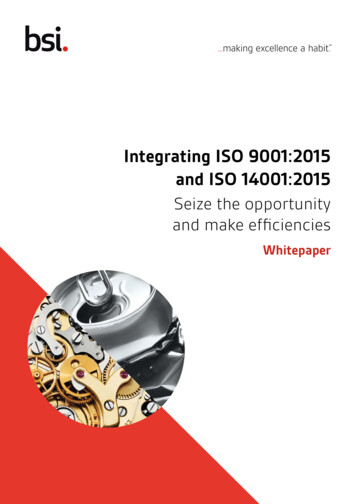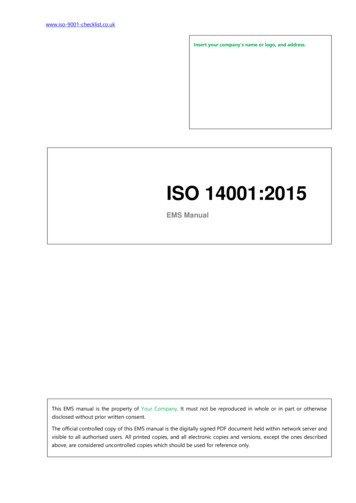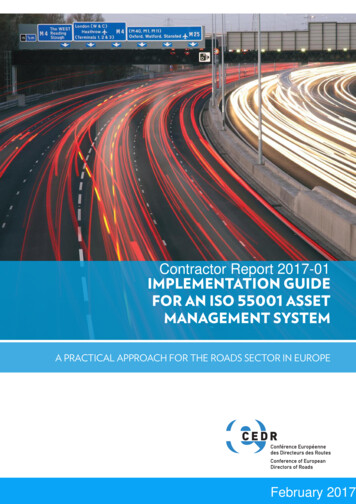
Transcription
Contractor Report 2017-01IMPLEMENTATION GUIDEFOR AN ISO 55001 ASSETMANAGEMENT SYSTEMA PRACTICAL APPROACH FOR THE ROADS SECTOR IN EUROPEFebruary 2017
IMPLEMENTATION GUIDE FOR AN ISO 55001 ASSET MANAGEMENT SYSTEMIMPLEMENTATION GUIDEFOR AN ISO 55001 ASSETMANAGEMENT SYSTEMA PRACTICAL APPROACH FORTHE ROADS SECTOR IN EUROPECEDR Contractor Report 2017-1 is an output from the CEDR TransnationalRoad Research Programme Call 2014: Asset Management andMaintenance. The research was funded by the CEDR members of Austria,Belgium-Flanders, Finland, Germany, Ireland, the Netherlands, Norway,Sweden, and the United Kingdom.The aim of the CEDR Transnational Road Research Programme is topromote cooperation between the various European road administrations inrelation to road research activities. The topics covered by this Call weredeveloped by TG Research to fulfil the common interests of the CEDRmembers.DISCLAIMERThe report was produced under contract to CEDR. The views expressed areOCTOBERthose of the authors and not necessarily those of CEDRor any of the2016CEDRmember countries.2
A PRACTICAL APPROACH FOR THE ROADS SECTOR IN EUROPEPRODUCTION TEAMCLIENTPEB Project ManagerJason GlassonPEB Project ManagerVesa MannistoWSP PARSONS BRINCKERHOFFProject Manager Chris BrittonProject Director James ElliottSUBCONSULTANTSEgis Road OperationJean PohuEgis Road OperationGraça CorreiaHyperion Infrastructure Consultancy LtdDr. Mike GibbHyperion Infrastructure Consultancy LtdChris SpongINDEPENDENT TECHNICAL REVIEWERDanish Road DirectorateBjarne SchmidtAny enquiries about this document should be sent to:James.Elliott@pbworld.comTel: 44(0)7837 319 143i
IMPLEMENTATION GUIDE FOR AN ISO 55001 ASSET MANAGEMENT SYSTEMKEY TO USING THIS DOCUMENTLight blue box-outs are used tohighlight quotations, particularexamples from case studies andresearch, or other publications.Blue box-outs are used to highlight conclusions and ‘tips’ that mayaid an organisation considering the implementation of an assetmanagement system which conforms with requirements of ISO 55001.Visual ‘flags’ are used to highlightsections of particular relevance toeach of the three types of y link to another relevantsection of the document, for furtherinformation:GO TOCHAPTER5GO TOAPPENDIX3GO TOSECTION4.2ii
A PRACTICAL APPROACH FOR THE ROADS SECTOR IN EUROPE‘SIGNPOSTING’ FOR DIFFERENT READERSYour Role?Your Role?Key PolicyMakerPreliminaryassessmentstage – assessrelevance ofISO 55001ManagerOperationsKey PolicyMakerManagerContext ( )Leadership ISO 55001 ElementsOperationsPlanning( ) ( )Support ( ) PerformanceEvaluation ( )Improvement ( )OperationThe Journeyto MaturityReview currentpoliciesFutureobjectives/demandReview currentprocessesReview currentpracticesReview assetknowledgeUndertakeGap AnalysisReview /ManageChangeContinuousPerformanceReviewDecision PointDrive ChangeImplementChanges andSAMPISO 55001SpecificActionsEngageStakeholdersDevelopa SAMPiiiManage AssetPortfolioCertificationAudit
IMPLEMENTATION GUIDE FOR AN ISO 55001 ASSET MANAGEMENT SYSTEMPREFACE – THE ARISE PROJECTFollowing the publication of ISO 55000 in February 2014, the ARISE project (Applicationto Roads of ISO 55000 using Exemplars) was initiated by the Conference of EuropeanDirectors of Roads (CEDR) in its 2014 Research Call through the topic ‘Why and How toimplement ISO 55000’. CEDR is an organisation which brings together the road directorsof 25 European countries, and the funding partners of the current Joint ResearchProgramme are the National Road Administrations (NRA) of Austria, Belgium-Flanders,Finland, Germany, Ireland, the Netherlands, Norway, Sweden, and the United Kingdom.Road Administrations around Europe have been on an evolving journey towards moresystematic and holistic management of their assets in recent years. Standardisation inthe approach to establishing an Asset Management System (AMS) – in its broadestsense – started with the publication of the British PAS55 specification in 2008. This hasnow attained international standing through the development of the new ISO standard,built on the PAS55 foundation. CEDR has instigated and supported a number of researchand development programmes with Asset Management (AM) as their theme, and inparticular established a Task Group (N2) under TD Network Management. In addition,CEDR inherited the results of the ERANET Road II (2010 Research Call) ‘Effective AssetManagement’ in 2013.The ARISE project was awarded to an international team of experts from the UK andFrance, with access to resources in Portugal and Denmark. The team was led by WSP Parsons Brinckerhoff, with partners EGIS Road Operation and Hyperion InfrastructureConsultancy.ARISE has focussed on producing advice and guidance for road sector organisationsconsidering why and how to implement ISO 55000; more specifically, after adoptingthe approach of ISO 55000, delivering an AMS means using ISO 55001 which is themanagement System Requirements. This Guide represents its primary published output,based upon examples gleaned from case studies of organisations which are at variousstages of their asset management system implementation, and which have specificexperience of IS0 55001 or its ‘parent’, PAS55. The project’s aim is to facilitate open andpractical dissemination of the principles of asset management as defined in ISO 55000to as wide an audience as possible, and this Guide performs a key role in that process.The Guide is intended to offer options and advice, rather than a ‘one-size fits all’ solutionto establishing a formal Asset Management System that will help organisations to obtainvalue from their assets. It provides evidence and examples gained from the earlierstages of the ARISE research project, including priorities based on typical costs andbenefits. The Guide does not contain a detailed way of assessing ‘maturity’, as this canbe found in other literature cross-referenced in the document. It does explain the ‘journeyto maturity’; along the path of which certification to ISO 55001 is one key milestone.The Guide does not primarily equip those tasked with performing asset managementactivities with new solutions, but rather explores the reasons for adopting a strategicapproach to asset management against the main themes in the international standard,ISO 55001.iv
A PRACTICAL APPROACH FOR THE ROADS SECTOR IN EUROPECONTENTS1GETTING STARTED 12THE CONTEXT OF INFRASTRUCTUREASSET MANAGEMENT 42.1 THE BACKGROUND OF THE ARISE PROJECT42.2 INTERNATIONAL INDUSTRY CONTEXT 52.3 WHERE ISO 55001 FITS IN52.4 HOW A STRUCTURED APPROACH ADDS VALUE63WHY IMPLEMENT AN ISO ASSET MANAGEMENTSYSTEM IN A ROADS SECTOR ORGANISATION?73.1 BENEFITS OF AN ASSET MANAGEMENT SYSTEM73.2 BENEFITS OF ISO 55001 CERTIFICATION93.3 CHALLENGES TO ISO 55001 CERTIFICATION133.4 SUMMARY AND CONCLUSIONS144EXPERIENCE OF ISO 55000 IN DIFFERENTINDUSTRY SECTORS 154.1 GENERAL CONSIDERATIONS 154.2 CONTEXT OF THE ORGANISATION194.3 STAKEHOLDER ENGAGEMENT AND COMMUNICATION224.4 LEADERSHIP234.5 AM POLICY AND OBJECTIVES 244.6 AM PLANNING 254.7 PEOPLE AND TRAINING264.8 DATA AND INFORMATION274.9 RISK MANAGEMENT294.10 IMPROVEMENT AND CHANGE MANAGEMENT304.11 SUMMARY AND CONCLUSIONS31v
IMPLEMENTATION GUIDE FOR AN ISO 55001 ASSET MANAGEMENT SYSTEM5IMPLEMENTING AN ISO 55001 SYSTEM IN YOURORGANISATION 335.1 DEFINING YOUR ISO 55001 ORGANISATION AND ROLES345.2 MAPPING YOUR ISO 55001 MATURITY JOURNEY355.3 IMPLEMENTING THE REQUIREMENTS OF ISO 55001 –GENERAL ACTIVITIES385.4 IMPLEMENTING THE REQUIREMENTS OF ISO 55001 –ACTIVITIES FOR POLICYMAKERS395.5 IMPLEMENTING THE REQUIREMENTS OF ISO 55001 –ACTIVITIES FOR ASSET MANAGERS 415.6 IMPLEMENTING ISO 55001 – ACTIVITIES FORASSET OPERATOR435.7 SUMMARY – PRINCIPAL CONSIDERATIONS FORIMPLEMENTATION OF ISO 550001 446COSTS AND BENEFITS 466.1 INTRODUCTION 466.2 CBA ANALYSIS FRAMEWORK476.3 DO NOTHING COSTS AND BENEFITS476.4 TIMESCALE FOR EVALUATION OF BENEFITS486.5 IDENTIFICATION AND ALLOCATION OF COSTS AND BENEFITS496.6 SUMMARY OF POTENTIAL COSTS AND BENEFITS TO ROADADMINISTRATIONS 506.7 PRINCIPAL CONSIDERATIONS FOR IMPLEMENTATION OFISO 55001753THE JOURNEY TO MATURITY – STEPS TOWARDSUCCESSFUL IMPLEMENTATION 557.1 GAP ANALYSIS557.2 CONSIDER OPTIONS/PLANS567.3 PLAN/MANAGE CHANGE56859WHERE TO LOOK FOR FURTHER HELPAPPENDIX 1 – SUMMARY OF CASE STUDY FINDINGSAPPENDIX 2 – COST BENEFIT ANALYSISAPPENDIX 3 – CROSS REFERENCING ISO 55001 &ISO 55002 IN A HIGHWAYS CONTEXTvi6094104
A PRACTICAL APPROACH FOR THE ROADS SECTOR IN EUROPE1WHAT IS ISO55000?GETTING STARTEDThe International standard for asset management comprises threecomplementary documents ISO 55000 – Overview, principles andterminology, ISO 55001 – Management System Requirements and ISO 55002– Management systems – Guidelines for the application of ISO 55001. Thestandard is aimed at enabling an organisation to obtain value from its assets.It is aimed at enabling an organisation to achieve its objectives through theeffective and efficient management of its assets. It offers a structured andwell-researched approach to Asset Management (AM) which can be appliedwhether an organisation already has a mature Asset Management System(AMS), or is just starting its journey to obtain value from its assets.The ISO 55000 Standard is primarily intended for use by: Those considering how to improve the realisation of value for theirorganisation from their asset base Those involved in the establishment, implementation, maintenanceand improvement of an asset management system Those involved in the planning, design, implementation and reviewof asset management activities; along with service providers.ISO 55000 para 0.3WHY SHOULD ITBE OF INTERESTTO A ROADORGANISATION?The Roads sector was perhaps a little slower than other infrastructure sectorsto formally adopt the concept of ‘asset management’, even though it may beargued that they had been ‘doing asset management’ for many years. RoadAdministrations around Europe have been on an evolving journey towardsmore systematic and holistic management of their assets in recent years.A wide variety of business models are now being adopted by this industry,from a traditional fully in-house arrangement, through a sliding scale ofoutsourcing of services, to a full PFI/PPP approach. This is discussed inChapter 3. Standardisation in the approach to establishing an AMS – in itsbroadest sense – started with the publication of British PAS55 specification in2008. This has now attained international standing through the developmentof ISO 55001, the adoption of which can bring many benefits to a RoadsOrganisation. These are explained in more detail in Section 2.4 and Chapter6. From this point forward we shall refer only to ISO 55001 unless otherwisestated.1
IMPLEMENTATION GUIDE FOR AN ISO 55001 ASSET MANAGEMENT SYSTEMWE ALREADYADOPTAN ‘ASSETMANAGEMENT’APPROACH,DOES THISAPPLY TO US?It is clear that many roads sector organisations – public administrations,contractors, operators and concessionaires – have seen the need to embracethe concept of holistic asset management. Many have re-engineeredtheir business processes accordingly and taken new approaches, forexample to the outsourcing of asset management services. Data, and theinformation systems required to manage them, are widely recognised askey to underpinning an asset management approach. The combination ofpolicies, processes, procedures and methods of working may be seen asan ‘asset management system’, but this cannot be objectively benchmarkedunless a standard approach is taken; so, even if your organisation is usingan asset management system approach, the adoption of a standard canprovide an accepted way of comparing with other similar organisations andbenchmarking good practice.In this Guide, you will find how ISO 55001 views the establishment of an AMSas a ‘journey’. Every organisation starts at a different point of maturity, andhas unique challenges in developing further; the point at which a decisionto aim for formal ISO 55001 certification will also vary from organisation toorganisation, and should depend on a sound internal business case beingmade.HOW WILL THISGUIDE HELP ME?WHAT IS THEBEST APPROACHTO READINGTHIS GUIDE?This Guide is aimed at people working in a roads organisation at a rangeof levels; Policy, Management, and Operations. You will find ‘flags’ drawingattention to which section may be particularly relevant to you (see the keyon page ii). The Guide draws upon real-world case studies, from a range ofcountries and industries. This is used to provide you with lessons learnedand hints and tips for your own ‘journey’. In developing the Guide, work hasbeen done on costs and benefits that, at a broad-brush level, will assistyou in making the initial investment decision whether or not to conform toISO 55001 requirements. It is important to remember that this is not a ‘onesize fits all’ approach; what your own organisation needs to do to adoptISO 55001 and become compliant will depend on a range of factors suchas your starting ‘maturity’, and the level of resources available and theircompetence.You will find advice on how to navigate round the document, and find theparts which are most relevant to you, in the ‘Key to using this document’ onpage ii. We have adopted a visual style that we hope will help you identifysections and paragraphs of particular relevance to you.2
A PRACTICAL APPROACH FOR THE ROADS SECTOR IN EUROPEHOW DO I FINDOUT WHAT TODO FIRST?HOW DOESTHE GUIDEHELP ME MAKEA BUSINESSCASE?DO I NEEDTO READ THEWHOLE GUIDE?In Chapter 5, you will find a description of the tasks you may need to gothrough in establishing an asset management system in a way that iscompliant with ISO 55001. It contains practical hints and tips, and theseare taken a step further in Chapter 7 which looks at the factors involved ina
TRANS-EUROPEAN TRANSPORT NETWORK. BASED ON THE OUTCOME OF THE INFORMAL TRILOGUE OF 27th JUNE 2013. IMPLEMENTATION GUIDE FOR AN ISO 55001 ASSET MANAGEMENT SYSTEM. A PRACTICAL APPROACH FOR THE ROADS SECTOR IN EUROPE. OCTOBER 2016. CEDR Contractor Report 2017-1 is an output from the CEDR Transnational Road Research Programme Call 2014: Asset Management

